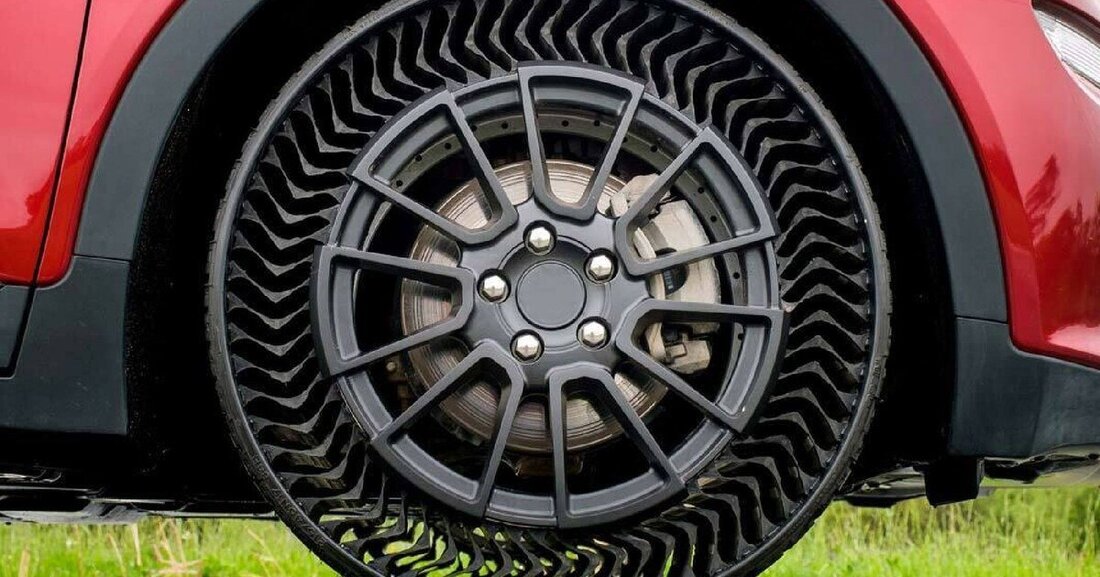Tires without risk of punctures
Years ago, Michelin introduced an airless prototype tire called the Uptis system. The market launch is scheduled to follow in 2024.

Tires without risk of punctures
An airless, robust tire that only shows tread wear under normal circumstances, but is otherwise indestructible against puncture and impact damage, would be a great invention. Both for companies (fleets) and end customers. A deflated tire does not require a tire pressure control and can practically not be used “incorrectly”, i.e. negatively influenced by too much or too little air pressure. Even storing it over the winter (or summer) would be easier. Michelin first demonstrated such a system in 2017 and has continued to develop it further. The “Uptis” has been available in its current form since 2019. Larger-scale pre-series tests are currently being carried out in everyday operations at delivery services such as DHL in Germany and France.
A maintenance-free, puncture-proof tire is a great product for end customers, but it also comes with a few downsides, especially for tire retailers and industry. The simple calculation: Any tire that becomes unusable due to damage must be replaced. For most cars this has to be done axle by axle. In this respect, any unspectacular tire damage is good business for the tire trade and industry. New tires have to be purchased, balanced and installed twice. Annoying for the end customer, good for driving safety and the tire industry. A concept like the Michelin Uptis can massively reduce the replacement business here. This is of course more sustainable and good for the environment, because even if the second tire on the axle is almost new, it still has to be removed so as not to confuse ABS and ESP. In the worst case scenario, one broken tire and one good tire end up in the disposal. If the puncture-free tire were a mass-produced product and installed on millions of cars, the industry would certainly feel the effects of the decline in sales of replacement tires. Unfortunately, it is currently not known whether an Uptis also needs to be replaced axle by axle in the event of damage. However, it would be obvious that the main argument for exchanging axles is the different wheel diameter between a new tire (with full tread) and a used tire (worn tread).
The next sticking point in the Michelin concept: the rim and tire are firmly and inseparably connected to each other via the slat honeycomb structure made of special resins and plastics, which practically forms the tire core. This means: If the tread is worn out, the entire wheel must be changed and not just the tire/tread. Conversely, this could mean that the accessory rim industry could suffer a massive drop in sales, as you cannot simply combine rims and tires as you like, but there could only be more “wheel-tire systems”. And how sustainable is it if the rim has to be replaced with every system where only the tread is actually removed? Here we would need a way to separate the rim from the tire and possibly reconnect the new tire and body structure to it in order to prevent unnecessary replacement. That would be really sustainable and could secure sales for tire specialist companies. Tire pressure monitoring systems were also eliminated, another source of income in the tire business.
The respective wheel-tire system could be 100 percent individually tailored to the respective vehicle. Rims and their dimensions have a massive influence on driving behavior in close coordination with the chassis. They are often considered to be specified by the manufacturer. The tire is the easily replaceable component and therefore a variable. With the complete wheel-tire system, a completely individual wheel would be conceivable for every vehicle, which is perfectly tailored to the respective needs. For sports cars, it's about maximum cornering performance, crisp steering behavior and high feedback; for sedans, it's about durability, comfort, low consumption, etc. What's attractive for vehicle manufacturers is that all the variables that arise solely from the wheel-tire combination options would be eliminated. Definitely a plus for driving safety, but a nightmare for the tuning scene, because in Austria and Germany it is worth several billion euros - per year.
The puncture-free tire will come sooner or later - perhaps even have to come. It is the logical further development, regardless of its downsides for certain business areas. It is doubtful whether this will actually happen in 2024. But everyday tests in fleet operations are becoming more frequent, and with the expertise gained we will have a finished product for the mass market in the next few years. Until then, the tire companies will once again have to stick with their tires and adapt.

 Suche
Suche
 Mein Konto
Mein Konto